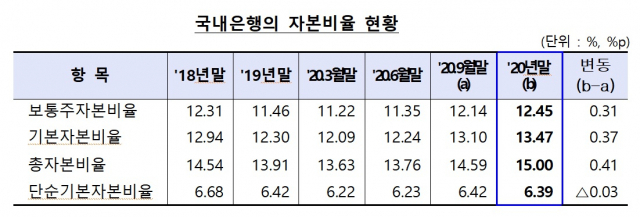30 trillion of risk-weighted assets in the introduction of the KDB and Kieun Basel III final draft ↓
Capital ratio of bank holding companies also rises
 viewer
viewer
The capital ratio, an indicator of the soundness of domestic banks, continued to improve at the end of last year. Capital increases due to net profit and increase in capital increase, as well as the significant decrease in risk-weighted assets of KDB Development Bank and IBK.
According to data released by the Financial Supervisory Service on the 17th, “Bank Holding Companies and International Settlement Bank (BIS) Standard Capital Ratios (tentative) at the end of 2020”, as of the end of last year, the total capital ratio based on BIS of domestic banks was 15.00%, compared to the previous quarter. 0.41%, up 1.08 percentage points (p) over the same period last year. The common stock capital ratio rose 0.31%p to 12.45%, and the basic capital ratio rose 0.37%p to 13.47%.
The capital ratio of domestic banks has been steadily improving since the second quarter of last year. The reason was the early application of the final draft of Basel III, which eased the criteria for calculating corporate loan credit risk by the financial authorities. Starting with JB in the second quarter, Shinhan, Woori, Kookmin, DGB, BNK, Nonghyup, and Suhyup introduced in the third quarter in order, and the soundness indicators improved significantly. In the fourth quarter, KDB and IBK applied this. For this reason, the size of domestic banks’ risk-weighted assets also decreased by KRW 30 trillion in the fourth quarter. The increase in capital was 3.4 trillion won. Under current regulations, banks must maintain a total capital ratio of 10.5%, a basic capital ratio of 8.5%, and a common stock capital ratio of 7% or more. If the capital ratio is below the baseline, profit dividends, etc. are limited, and the bank is advised to take measures to improve management.
 viewer
viewer
By bank, KDB (15.96% of total capital ratio), which introduced the final draft of Basel III in the fourth quarter, saw a significant increase in capital ratio, and Shinhan (15.73%), Kookmin (15.27%), Nonghyup (15.18%), Hana (14.18%) ), Woori (13.75%) and all banks, including large banks, exceeded the BIS standard regulation ratio. Internet banks Kakao Bank and K-Bank had a total capital ratio of 20.03% and 17.90%.
The capital ratio of bank holding companies also rose. The total capital ratio of bank holding companies was 14.61%, up 0.14%p from the previous quarter. The common stock capital ratio rose 0.21%p to 11.91%, and the basic capital ratio rose 0.16%p to 13.17%.
An official from the Financial Supervisory Service said, “Some banks have a relatively low common stock capital ratio even when applying the final draft of Basel III, and conservative capital management is necessary.” We will induce effective capital management.”
/ Reporter Kim Sang-hoon [email protected]
< 저작권자 ⓒ 서울경제, 무단 전재 및 재배포 금지 >
